April 14th, 2021
Preteens Or Teens With Missing Front Teeth
How did we get here?
Do you have a child with a missing upper front tooth? If you do, this blog will provide useful information to help you decide what to do.
There are 3 options.
1) If there is a baby tooth in the position of the missing tooth, keep it . This is not a long term proposition because the baby tooth will be lost (you’ll be lucky if the tooth last 15 years).
2) Open space for the missing tooth– This is usually the best if you are missing one front tooth, as closing the space for one tooth can create an asymmetry. In the photos below the patient is missing one front tooth. With orthodontics, we created space for the tooth then her dentist placed a Maryland Bridge. 
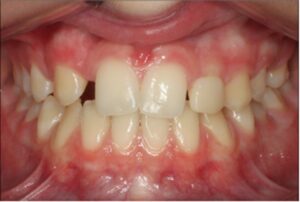
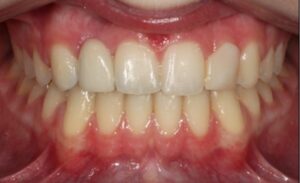
3) Close space for the missing tooth (teeth). This option when possible is the best solution long term as it can alleviate the need for further dental treatment (i.e. the need to replace 2 missing teeth). If handled properly the esthetics of the smile are significantly enhanced. Also you avoid the long term cost for the repeated replacement of the restorations (expect to replace each restoration 4 times over a lifetime). The patient below is a perfect example of this. We closed the space for the two side front teeth and reshaped. 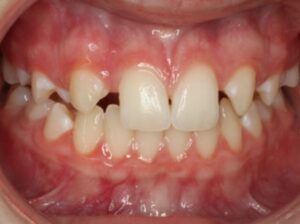
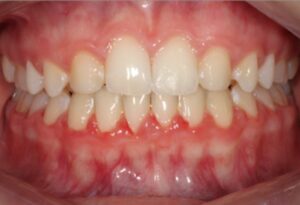
The last example is a patient with a missing front tooth. As I mentioned above, the best results usually involves opening space for the missing tooth because of the asymmetry created but with well planned orthodontics and dental restoration, we were able to develop the esthetics without opening any space.

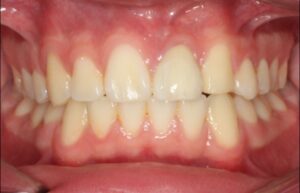
As you have learned there are options for handling missing front teeth. At our office, we review the possibilities and help you make the right choice for your child.
Let us know how we can help!
Tags: Orthodontics, Adult Braces, Airway, Atlanta, Braces, Clear braces, Child braces, Close space, Teen missing teeth, Preteen missing teeth, Elite Smiles Chastain, Missing Front Teeth
Posted in Uncategorized | No Comments
April 14th, 2021
10 Things You Didn’t Know About Your Teeth
You use your teeth to bite, chew and talk countless times throughout your day. Unless something is bothersome, you probably don’t give your grill a second thought. So, with our compliments, gnaw on this enlightening list of ten things you didn’t know about your teeth – but guess what – your American Association of Orthodontists member orthodontist did!
- A tooth can come into the mouth with a cavity.
- A cavity is one of the few things the body cannot heal. It just gets larger with time, unless a dentist removes the decay and places a filling.
- A tooth can grow in upside down, sideways or backwards.
- Baby teeth hold space for the permanent teeth that follow – it’s important to hang onto them until they’re ready to come out on their own.
- While we’re on the subject of baby teeth, they’re also called “deciduous” teeth – from the Latin word “decidere,” which means to fall off or be shed (like leaves from a deciduous tree).
- Teeth by the numbers: we get two sets of teeth – 20 baby teeth and 32 (usually) permanent teeth – unless you get extra teeth (supernumerary teeth), or some teeth never develop (congenitally missing teeth). Thank your genes for extra or missing teeth.
- Research suggests that some sweet flavors in e-cigarette liquids may increase the risk of getting cavities. (As if nicotine addiction wasn’t enough already.)
- Back teeth are called “molars.” They are used for grinding food when you chew.
- Diet soda and sports drinks can be just as tough on teeth as regular soda. Both contain acid. Acid attacks the enamel surface of your teeth and can lead to cavities. Some bottled waters and flavored bubbly waters can be acidic enough to cause cavities too!
- The part of the tooth you see, the crown, is only about a quarter to a third of the entire tooth. The rest of the tooth is under the gums.
Now that you have mastered these tidbits about teeth, you can amaze your friends and family with your trivial knowledge. But your teeth are anything but trivial. Healthy teeth and gums are critical contributors to your overall good health.
March 23rd, 2021
Closing Space for Missing Front Teeth

Missing an upper front tooth (or teeth) is difficult for anyone but especially a teen. They have to have a temporary fix ( i.e. Maryland bridge or removable “flipper” with a false tooth on it) until they stop growing. Then an implant (post placed in the bone) can be placed upon which a crown is attached. This can occur in females around 18 years and males 22 yrs. Over the years the crown and implant will have to be replaced (every 15-25 years).
So you can see the process for replacing a missing tooth is long and never ending, not to mention the many times when the cosmetics are just not that good.
Dr. Michael Sebastian has spent countless hours developing strategies to avoid this potential nightmare by closing the space for a missing tooth. As the following example demonstrates. This 12 year old boy was missing teeth on both sides adjacent to the front teeth (lateral incisors). The strategy for closure is outlined below:
1) Encourage upper eye teeth to come in by the front teeth by selective removal of baby teeth over a 2 to 3 year period. (no braces involved) 4 office visits are needed.

2) Orthodontically manipulate the eye teeth and first bicuspids into a position which simulates the tooth and gum positioning of the teeth they are replacing (lateral incisors and eye teeth).
3) Cosmetically contour these teeth to develop the shape of the missing teeth.
If these strategies are followed then very nice cosmetic results through Orthodontics can be attained. The best of which is they can enjoy their smile when they are teens and don’t have a lifetime of implants and crowns!

Let us know how we can help!
March 9th, 2021
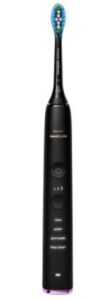
Do you know which electric toothbrush to choose?
There are 2 basic types of electric toothbrushes depending on how the toothbrush bristles rotate.
- Side to Side
- Oscillating (moves in a circular pattern)
Well, the American Dental Association recently published an extensive study of these 2 types. Which one was best?
Neither! They both were equally as effective in removing plague thereby improving gum and tooth health (Look Ma, no cavities!)
So, if you are in the market for an electric toothbrush, either of these types will do a great job. Just remember to brush 2 times a day for 2 minutes each time. Focus on brushing the area where the teeth and gums meet. Floss once per day.












